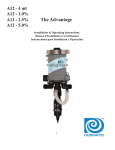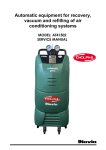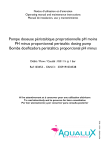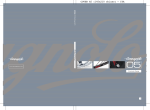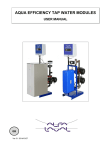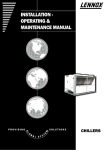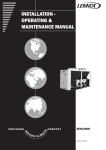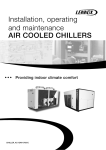Download York MOH 55 Specifications
Transcript
MINISPLIT Single Circuit Cooling only and Heat Pump Systems Models MOC / MOH 07 to 55 G Series TECHNICAL GUIDE Outdoor air cooled condensing units n e i b m a w Lo “ ” e n i l t MOC /MOH 45 to 55 MOC /MOH 25 & 35 R407c MOC / MOH 07 to 18 YORK ® List of contents Page 1 -Safety .....................................................................................................................................................................................3 2 -Outdoor units ......................................................................................................................................................................3 3 -Technical Specifications ................................................................................................................................................3 4 -Dimensions ..........................................................................................................................................................................4 5 -Installation ............................................................................................................................................................................5 6 -Refrigeration circuit connections ...............................................................................................................................6 7 -Electrical connections .....................................................................................................................................................7 8 -Defrost ....................................................................................................................................................................................8 9 -Regulator ..............................................................................................................................................................................9 10 -Trouble-shooting guide ............................................................................................................................................... 10 11 -Accessories .......................................................................................................................................................................12 12 -Technical Appendix .......................................................................................................................................................12 Minisplit unit start-up check-list Parts List : (Contact York) Decommissioning, Dismantling and Disposal Product designation MOC 25 G 15 PDFGH Factory fitted options P: Q: D: F: G: H: Type MOC : Minisplit Outdoor unit, cooling only MOH : Minisplit Outdoor unit, heat pump rotary compressor scroll compressor pressure operated low temperature kit hot gas bypass valve crankcase heater not fitted as standard compressor starting kit Voltage code 15 = 220-240V/1Ph/50Hz 35 = 380-415V/3Ph/50Hz Size in MBTU/h 07 = 09 = 12 = 18 = 25 = 35 = 45 = 55 = 2 2 kW 2.4 kW 3.4 kW 5.0 kW 6.3 kW 8.6 kW 12.0 kW 13.8 kW R407C For all correspondance with YORK, please state complete machine references and serial numbers. 1 - Safety 2 - Outdoor units Installation and maintenance of this air conditioning system should only be carried out by trained and qualified personnel. Regular maintenance operations such as cleaning the coils and air filters must be performed to keep the units in proper operating condition. The units are shipped complete with a charge of R407c refrigerant sufficient for a piping length of 7,5 metres. CAUTION The unit support plate is shaped in such a way that water produced during defrost operations on heat pump units is collected at a single point where it can be easily drained off. No accessory drain pan is required. Before undertaking any work on the unit, make sure that the power supply has been disconnected. ELECTRICAL CONNECTIONS All electrical wiring and connections must comply with local standards. GENERAL PRECAUTIONS Check that the power supply available agrees with nameplate voltage. Use adequate line protection. The unit must be grounded. 3 - Technical specifications Model Outdoor unit Indoor unit Cooling and heating MCC-MCH MHC-MHH MKC-MKH MAC-MAH kW kW kW kW Compressor Refrigerant Type Location Power supply V/Ph/Hz kW Power input A Nominal current Starting current A dB(A) Noise level at 2,5m H (mm) W (mm) Overall dimensions D (mm) kg Net weight MOC kg Net weight MOH Type of connection Piping Gas Diameter Liquid Refrigerant charge MOC / MOH g Air flow m3/h Number of fans Expansion device The Nominal Cooling Capacity is based on : - Indoor Air Temp. 27°C DB / 19°C WB - Outdoor Air Temp. 35°C DB Piping Length : 5 meters 07G 2,0 - 09G 2,4 2,2 - 12G 3,4 3,2 3,3 Rotary MOC-MOH 25G 18G 4,7 6,3 4,6 6,0 5,0 6,2 4,7 6,3 35G 8,6 8,4 8,6 8,6 45G 12,0 12,0 12,0 Scroll 55G 13,8 13,8 13,8 R 407C Capillary Restrictor Indoor unit Outdoor unit 380-3-50 220/240-1-50 0,7 0,89 1,68 2,6 3,6 1,25 3,2 4,3 3,4 4,1 7,7 12,4 5,6 7,8 5,9 6,6 17 23 35 81 60 62 47 46 40 40 40 51 52 53 52 46 492 492 696 1142 1142 900 590 492 764 764 850 1060 1060 1060 820 764 230 230 287 345 345 345 280 230 32 38 42 68 121 107 132 62 34 40 43 69 122 108 133 63 Flared connection with nut 3/8" 1/2" 5/8" 3/4" 3/8" 5/8" 5/8" 3/4" 1/4" 1/4" 3/8" 3/8" 1/4" 3/8" 3/8" 3/8" 680 / 620 720 / 1000 1150 1880 2100 3650 3000 4000 1 220 1 220 3 310 3 310 3 832 4 748 7 885 1 220 1 1 1 1 1 1 2 2 The Nominal Heating Capacity is based on : - Indoor Air Temp. 21°C DB - Outdoor Air Temp. 7°C DB/6°C WB Piping Length : 5 meters 3 4 - Dimensions Overall dimensions MOC/MOH 07 to 18 MOC/MOH 25 to 35 W L L MOC/MOH 45 to 55 W L W Distances between mounting hole centres MOC/MOH L (cm) W (cm) 07-09-12 18 25 35 - 55 49.7 51.7 55 74 24,8 29.6 31.5 37.5 Outdoor unit clearances A minimum of clearance is necessary around the units to ensure proper air circulation and easy access for maintenance. MOC/MOH 07 to 18 MOC/MOH 25 to 35 MOC/MOH 45 to 55 A A A B D B 4 E D E C C 07 to 18 E B 25 MOC - MOH 35 45 55 A 500 300 300 300 300 B 200 500 600 600 600 C 100 100 100 100 100 D 600 600 800 800 800 E 190 210 210 210 300 C D 5 - Installation Unit installation entails: - unit mounting - refrigerant piping connections - condensate water drainage connections - unit wiring connections. OK Whatever type of installation is chosen for the unit, the following installation rules must be observed: - The location selected for unit installation must be capable of withstanding the weight of the unit in its full operating configuration. - In particularly windy places, the unit should be installed so that the prevailing wind does not interfere with air discharge from the unit (configuration with the wind blowing onto the side of the unit). - If the outdoor unit is installed on the ground, make sure that the location is not liable to flooding. - MOH heat pump unit : install the unit at least 10 cm above ground level to facilitate drainage of defrost water and prevent accumulation of ice. In eff e t , defrost water can cause accumulation of ice under the unit during sub-freezing outdoor temperatures. - Make sure that you know and apply any and all local rules and regulations concerning the installation of air conditioning equipment. - Wherever possible, install the unit where it will be protected from rain, snow and run-offs from overhanging structures. - Use the vibration isolators provided to prevent vibration transmission and resulting unnecessary noise. - In areas with heavy snowfall it is best to install the unit on wall supports. - Do not install the equipment in explosive environments. - If condensates are not to be drained, do not install the elobow supplied with the unit. - Make sure that the surrounding atmosphere does not contain noxious or dangerous substances such as oil vapours or sulphur. - Make sure that the unit is installed level so that condensates will drain off correctly. - Select a location where neither dust nor other foreign bodies will clog the unit coil. - If the air conditioner is installed in a polluted area, increase the frequency of maintenance operations. - Avoid installing the unit where it will be in direct sunlight, especially if it is a cooling only model since direct sunlight will increase condensing pressure and reduce unit efficiency. Install units facing North whenever possible. - In some regions, it is necessary to heat the bottom of the condensate drainage pan and the condensate drainage piping to avoid ice formation, and resulting ice build-up in the fan compartment (heater strip must be at least 25 W/m). - All devices using fitted with electronic equipment are sensitive to lightning. It is therefore wise to protect the installation with a surge arrestor. 5 6 - Refrigerant circuit connections Make piping runs as short as possible and avoid all unnecessary changes in direction or elevation. Insulation To prevent heat loss, the two lines must be insulated separately Use an appropriate bending tool to form curves and avoid flattening the refrigerant tubes. Fix piping with pipe clamps and make sure that any eventual pipe vibrations cannot be transmitted to the building structure. Use refrigeration quality piping only with an operating pressure rating of at least 30 bars. Never use ordinary «plumbing» quality piping : you MUST use special de-oxidised, dehydrated, refrigerant quality copper piping. Minimum thickness 6 mm Heat pump (discharge) L Pipe lengths Liquid • Maximum piping lengths MOC-MOH 07 D (m) 10 L (m) 15 H (m) 7 09 10 15 7 12 10 15 7 Gas D 18 10 15 7 25 15 25 10 35 15 25 10 45 15 25 10 Cooling 55 15 25 10 Note : Where the difference in elevation between the indoor unit and the outdoor unit is greater than 5 metres, install an oil trap every 5 metres. Cooling (suction) Heat pump (discharge) L The suction line must have a 2% gradient up to the compressor on horizontal sections. Where piping lengths are unusually long and include a large number of oil traps, it may be necessary to adjust the compressor oil charge. Heat Pump Liquid • Refrigerant charge to be added per extra 5 meter of piping length MOC-MOH g/m 07 15 09 15 12 15 18 65 25 65 35 65 45 65 Cooling (suction) 55 65 Refrigerant piping connections (FLARE connections) Low pressure To avoid alteration of unit capacities, make sure that piping lengths and changes in elevation are kept to a strict minimum. - Open the service valves and top up the refrigerant charge if necessary. 6 Cooling High pressure Manifold Before connecting the refrigerant lines, follow the procedures below (if pre-charged connection lines are not supplied) : - Select copper pipe diameters according to the size of unit to be installed. - Install the refrigeration lines, making sure that no foreign bodies get inside the piping. - Install the flare connectors and flare the ends of the pipes. - Evacuate the piping. This operation, which should last at least 15 minutes or even longer if there are large piping lengths and changes in elevation, should be followed by a leak test. To this effect, when the piping has been evacuated, close the pressure guage tap, note the value on the guage, then wait for 15 minutes. If the needle moves, there is a leak in the system. Make the necessary adjustments or repairs and repeat this procedure until the needle no longer moves. For greater precision, use a vacuometer, or pressurise the installation with 25 bars of dry nitrogen. H Gas Pressure Liquid valve tap MOC/MOH 25 G Outdoor unit Gas valve Indoor unit Gas line Liquid line R407C 7 - Electrical connections MOC 07 - 25 - Cooling only E E A MOH 07 - 25 - Heat pump Indoor unit N 1 2 N 1 2 E E A N 1 2 N 1 2 Indoor unit 3 3 Outdoor unit Power supply 220V/1Ph/50Hz Outdoor unit Power supply 220V/1Ph/50Hz MOC 35 - 55 - Cooling only E N E R 1 S T 2 N 1 MOH 35 - 55 - Heat pump Indoor unit 2 E N 1 2 3 Indoor unit E R S T N 1 2 3 Outdoor unit outdoor unit Power supply 380V/3Ph/50Hz Power supply 380V/3Ph/50Hz Wire sizes MOC / MOH Power supply 07 09 mm2 12 18 25 3 x 2,5 Interconnection Cooling mm 4 x 2,5 (Ind./Out.) Heating mm 2 5 x 2,5 A 10 45 55 5 x 2,5 2 Fuse (Slo-blow) 35 16 20 Terminals N and 1 (see diagrams above) correspond to power supply to the indoor unit coming from the outdoor unit. Compressor power supply is established by terminal 2. Power supply to the 4-way valve is established by terminal 3. 16 20 For further details on wiring of these units, see the diagrams pasted inside each unit. 7 8 - Defrost Defrost is handled via a defrost management electronic control board (model with two potentiometers and 6 dip switches, see diagram n°2). This enables defrost cycles to be initiated when the temperature reaches -5°C at the condenser coil bend. The end of defrost cycle set point is +10°C. The duration of the defrost cycle varies depending on operating conditions but it is limited to a maximum of 10 minutes. Time delay between successive defrost cycles is 30 minutes. ON Transformer Transformateur 1 2 34 The time delay between successive defrost cycles and the maximum duration of each cycle are adjustable. If these need to be modified, please contact YORK first for technical advice. - Low and high pressure switch settings on units : MOC/MOH 35-45-55-65 LP = 1.5 Bars HP = 28 Bars ➀ Start of defrost cycle temperature adjustment potentiometer ➁ End of defrost cycle temperature adjustment potentiometer ③ "Dip Switches" for adjusting time delay between defrost cycles and maximum defrost cycle duration. ➃ Female sensor connection ⑤ Shunt these terminals to simulate a defrost cycle 5 6 DEF Depending on the climate, it may be necessary to adjust defrost cycle start and end temperatures. This is done with a screwdriver : adjust potentiometers 1 and 2 . 8 The defrost cycle can be forced into action by shunting terminals DEF on the defrost control board in the outdoor unit. Diagram n°2 - Adjustable Defrost Control Board Once the adjustment has been made, Disconnect the main power supply, wait 2 to 3 seconds then reconnect the power supply to reset the defrost control board. 9 - Regulator 9.1 - Low temperature kit Installation of the low temperature kit should be envisaged whenever a unit must operate in cooling mode (in heating mode the kit is bypassed), at temperatures below the standard operating limits. If the kit is not installed and the unit is operated under such conditions, condensing pressure will be so low that the indoor unit coil will become frosted. The function of the pressostatic low temperature kit is to maintain condensing pressure at a constant value, when the outdoor temperature drops, by reducing the speed of the fan on the outdoor unit. Condensing temperature can be measured by a direct pressure reading using the Schrader valve. Factory setting is 16 bars, i.e. 45°C. Condensing pressure to be maintained is adjustable if necessary (ref a) with a screwdriver. The condenser fan is controlled proportionnaly by a triac. Minimum voltage supplied by the controller is 45% of input voltage. This is a fixed value. If for climatic reasons, condenser fan speed has to be reduced, complete stoppage of the fan can be obtained below the minimum voltage attained. Set the selector (ref b) on the "Cut Of” position to obtain fan stoppage. The initial position is “Min. Speed”. 9.2 - High pressure switch (inter-season starting kit) for MOH This high pressure switch is only active in the heating mode and controls a hot gas bypass valve.This control device opens the hot gas bypass valve at 25bars and cuts out at 17 bars. It is usually activated during the following phases : - Start-up when the conditioned space is cold and the coil on the air handling unit is at a temperature lower than 35°C (indoor fan does not operate at coil temperatures lower than 35°C in the heating mode). - Final phase of defrost cycle. - Start-up in heating mode during the inter-season. 9 10 - Trouble-shooting guide Note : Open the main unit power switch before proceeding with any repair operations. Symptoms Cause Remedy No heating or cooling The compressor and outdoor fan do not operate The outdoor fans runs but the compressor will not start Power failure Contact the electrical utility company Fuse blown or circuit breaker open Replace the fuse or reset the breaker Voltage is too low Find the cause and fix it Faulty contactor, thermostat or relay Replace the faulty component Electrical connections loose Retighten the connections if necessary Faulty capacitor (single phase models) Find the cause, then replace capacitor Thermostat adjustment too low (in heating mode) or too high (in cooling mode) Change thermostat setting Incorrect wiring, terminals loose Check and retighten Pressure switch tripped (depending on model) Find the cause, then reset Motor windings cut or grounded Check the wiring and the compressor winding resistance Faulty capacitor (single phase models) Find the cause, then replace capacitor Insufficient heating or cooling Low refrigerant charge Make sure there are no leaks Remove charge, repair, evacuate and recharge Insufficient airflow Check the air filter, the damper positions. Check that air is not being recycled Clean or replace, set the air damper to the right position Check cleanliness of unit coils Clean the coils Capillaries obstructed or orifice plugged (humidity) Remove charge, repair, evacuate and recharge Liquid and gas lines insulated together Insulate them separately Systems operates for long periods or continuously The compressor runs continuously Thermostat adjustment too high (in heating mode) or too low (in cooling mode) Change the setting No fan operation or faulty fan Check condenser air circulation Refrigerant charge too low, leakage Find leak, repair and recharge Heating/cooling load underestimated Reduce load or use next unit size up Air or incondensables in refrigerant circuit Remove charge, evacuate and recharge Unit short-cycles The compressor starts but shuts down quickly on thermal protection 10 Too much or too little refrigerant Remove charge, evacuate and recharge Air or incondensibles in refrigerant circuit Remove charge, evacuate and recharge Faulty compressor Determine the cause and replace compressor Power supply voltage too high or too low Solve the problem Faulty condenser (single phase models) Determine the cause and replace Faulty thermostat Replace Restriction in the refrigeration circuit Find restriction and repair. Frosted or plugged expansion device Remove charge, evacuate and recharge Poor airflow on indoor or outdoor unit Clean the coil and the filter if necessary, check that motors are operating properly Faulty power supply Check wire guages, etc Changeover valve damaged or blocked open (heat pump units) Replace it 10 - Trouble-shooting guide (Cont’d) Frosted indoor coil Ice build-up on indoor coil Low refrigerant charge, refrigerant leak Repair the leak and recharge Insufficient airflow Check the condition of the air filters Check the cleanliness of the indoor coil Check fan motor operation Check that the air damper opens correctly (on units equipped with a damper) Low operating temperature limit exceeded Install a low temperature kit Unit noisy Faulty installation Compressor noisy Make sure vibration isolators have been installed. Check piping collars. Tighten any loose components Make sure that the compressor is not losing oil Repair and add oil Excessive oil or refrigerant charge Remove excess charge Electric heat does not work (on indoor units fitted with this option) Thermostat Thermostat incorrectly adjusted Readjust the thermostat Repair or replace the thermostat Safety device Check continuity through fuse Replace faulty elements Safety thermostat opens Check indoor unit airflow Check cleanliness of air filter and coil Open air balancing dampers If ducts are long, inhibit low, and perhaps even medium fan speeds Faulty unit wiring Check that wiring complies with applicable diagrams Excessive or insufficient discharge pressure Excessive discharge pressure Insufficient discharge pressure Outdoor coil dirty Clean the coil Indoor unit fan (heating mode) or outdoor unit fan (cooling mode) faulty Replace the fan Excessive refrigerant charge Remove excess charge Air or incondensables in refrigerant circuit Check the circuit, evacuate, and recharge Refrigerant charge too low Find and repair the leak, top up refrigerant charge Liquid line blocked or crushed Find obstructions and eliminate them. Compressor valves worn out or leaking Replace the compressor Excessive or insufficient suction pressure Excessive suction pressure Insufficient suction pressure Refrigerant overcharge Remove excess refrigerant Cycle changeover valve faulty or leaking (heat pump units) Replace the valve Low refrigerant charge Add some refrigerant Outdoor unit coil (heating mode) or indoor unit coil (cooling mode) frosted Find cause and fix it Insufficient airflow on the outdoor unit coil (heating mode) or the indoor unit coil (cooling mode) Make sure that the indoor or outdoor unit fan is operating properly Suction line obstructed Find obstruction and eliminate Expansion device obstructed or iced up. Remove charge, evacuate, recharge Poor contact the line and and the defrost sensor in the heating mode (heat pump units) Reinstall the sensor correctly using a contact compound. Insulate the assembly Condenser airflow too high (in the cooling mode) in relation to outdoor air temperature Install a low temperature kit 11 11 - Accessories Floor supports and wall supports Type of support Floor Wall MOC-MOH Ref. A B C 07 to 18 25 to 55 07 to 12 18 25 to 55 AMF44B AMF50A AMW42A AMW50A AMW65A 350 500 420 495 650 100 100 500 600 750 100 100 44 44 44 A B Model AMW65A only C B A C Wall mounting support Floor support 12 - Technical appendix Unit Capacity Capacity correction factor for piping length (C2) Total cooling capacity can be determined by using correction factors C1, C2 and C3. Given cooling capacity = Cooling capacity at standard rating conditions x C1 x C2 x C3. Indoor unit Piping length (m) 7.5 10 1 0.98 Correction factor C2 C1 = Capacity correction factor for temperature C2 = Capacity correction for piping length C3 = Capacity correction for indoor unit fan speed Capacity correction factor for indoor fan speed (C3) Indoor unit Capacity correction factor for temperature (C1) Fan speed Cooling capacity correction factor Indoor Temperature °C WB 23 19 14 19 1.10 0.88 Correction factor C3 Outdoor Temperature °C DB 25 30 35 40 1.20 1.08 0.86 1.15 1.04 0.84 1.11 1 0.82 1.06 0.96 0.79 46 1 0.90 0.74 Heating capacity correction factor Medium Low 1 0.90 0.75 Operating temperature limits Cooling mode Heating mode Maximum Minimum +46°C 0°C (-10°C with fan stoppage) +28°C (heat pump mode) -10°C Outdoor Temperature °C WB Indoor Temperature 12 High °C DB 23 14 1.20 10 1.04 6 0.96 0 0.77 -8 0.58 20 17 1.25 1.30 1.10 1.13 1 1.04 0.80 0.83 0.69 0.63 Correction factors (C1) determine the instantaneous capacity (which does not take account of defrosting on heat pump units). These capacities may vary slightly, depending on the size of the unit. 12 - Technical appendix (cont’d) Cooling circuit diagrams Outdoor unit Indoor unit Outdoor unit Cooling only - MOC 07-09-12-18-25 Indoor unit Heat pump - MOH 07-09-12-18-25 Legend: 1. Compressor 2. Outdoor unit coil 3. Capillary tube 4. Indoor unit coil 5. Refrigerant circuit piping 6. Isolating valve with pressure tap Outdoor unit 7. 8. 9. 10. 11. High pressure switch (intermediate season safety in heating mode) Anti-slugging receiver 4-way cycle changeover valve Non-return valve Pressure operated low temperature kit (activated in cooling mode) Indoor unit Outdoor unit Cooling only - MOC 35-45-55 Indoor unit Heat pump - MOH 35-45-55 Legend 1. Compressor 2. Outdoor unit coil 3. Combined HP/LPpressure switch (manual reset for the HP switch) 4. Indoor unit coil 5. Refrigerant circuit piping 6. Isolating valves with pressure taps 7. 9. 10. 11. 12. HP pressure switch (interseason start-up safety in heating mode) 4-way cycle changeover valve Anti-slugging receiver Restrictor Pressure operated speed control (activated in cooling mode) 13 YORK ® Contractor Location : Order/invoice number : Installation start-up date : Minisplit unit start-up check-list Equipment reference numbers Indoor unit Outdoor unit Type Type Serial Number Serial Number Power supply and unit Single phase 3 Ph1-2 = V A Neutral interconnection cables Ph/N = V Ph2-3 = V A yes with corresponding currents Ph = A V A no Ph3-1 = 2 Power supply cable Guage = mm Length = Interconnection cable Guage = mm2 Length = Type of line protection Type Current = Check that all electrical connections are tight and that the unit is properly earthed Refrigeration piping Ø liquid = in. l. liquid = Ø gas = in. l. gas = Position of indoor unit Height of the unit = m Height of the room = Dif. in elevation between units indoor > outdoor m ext > int Changes in direction Number of oil traps = Number of bends = Condensate pump Pumping height = m Type of drainage = Condensate drainage U-Bend ❑ yes ❑ no Ø drainage piping = Evaporator Return air temperature = °C Air discharge temp. = Condenser Inlet air temperature = °C Outlet air temp. = Temperature measurements Superheat = °C Sub-cooling = Low temperature kit ❑ yes ❑ no Fan rotation correct (direction) ❑ yes ❑ no Suction pressure LP at low speed = Bar LP at high speed = Discharge pressure HP at low speed = Bar HP at high speed = Compressor Amps I at low speed = A I at high speed = Control thermostat cut out (open)= °C cut in (closed) = Low pressure switch trip = Bar reset = High pressure switch trip = Bar reset = Refrigerant charge top-up ❑ yes / quantity = g ❑ no Oil top-up ❑ yes / quantity = g ❑ no Checked unit charge ❑ yes ❑ no Check that you have : ✓ ✓ ✓ ✓ ✓ ✓ ✓ ✓ Completely opened the isolating valves. Insulated the gas and liquid lines separately. Tightened all flare connections. Leak-tested the entire installation. Evacuated the refrigeration circuit. Tested all functions of the air conditioner in the heating and the cooling mode. Tested the crankcase heater for correct operation. Installed the units in accordance with all instructions given in the documentation. Name, address and phone number of your contractor : 14 Earth yes no m m A m m m m cm °C °C °C Bar Bar A °C Bar Bar CONFORMITY DECLARATION FOR MACHINES WE: C.R. YORK, S.L. PASEO ESPRONCEDA, 278, 08.204 SABADELL DECLARE UNDER OUR OWN RESPONSIBILITY THAT THE MACHINE: DESIGNATION: Split System Outdoor Unit TYPE: MOC 07 to 55 and MOH 07 to 55 SERIAL NUMBER: IS IN COMPLIANCE WITH THE REQUIREMENTS OF: •APPLICABLE EEC DIRECTIVES 89/392/EC, 89/336/CEE • NATIONAL STANDARDS AND TECHNICAL SPECIFICATIONS ISO 9001, (Pr EN378) AND IN ACCORDANCE WITH THE FOLLOWING HARMONIZED STANDARDS • EN60204-1, EN292-1, EN292-2, EN563, EN294, EN953, EN55014, EN60555-2, EN50082-1 NAME SURNAME POSITION SIGNATURE : : KACHIT : SRIMUNCHU : Quality Manager DE-COMMISSIONING DISMANTLING & DISPOSAL This product contains refrigerant under pressure, rotating parts, and electrical connections which may be a danger and cause injury ! All work must only be carried out by competent persons using suitable protective clothing and safety precautions. Read the Manual 1. 2. 3. 4. Risk of electric shock Unit is remotely controlled and may start without warning Isolate all sources of electrical supply to the unit including any control system supplies switched by the unit. Ensure that all points of electrical and gas isolation are secured in the OFF position. The supply cables and gas pipework may then be disconnected and removed. For points of connection refer to unit installation instructions. Remove all refrigerant from each system of the unit into a suitable container using a refrigerant reclaim or recovery unit. This refrigerant may then be re-used, if appropriate, or returned to the manufacturer for disposal. Under NO circumstances should refrigerant be vented to atmosphere. Where appropriate, drain the refrigerant oil from each system into a suitable container and dispose of according to local laws and regulations governing disposal of oily wastes. Packaged units can generally be removed in one piece after disconnection as above. Any fixing down bolts should be removed and then the unit lifted from position using the points provided and equipment of adequate lifting capacity. Reference MUST be made to the unit installation instructions for unit weight and correct methods of lifting. Note that any residual or spilt refrigerant oil should be mopped up and disposed of as described above. After removal from position the unit parts may be disposed of according to local laws and regulations. YORK ® E - TEC - M0211 Europe YORK INTERNATIONAL Manufacturer reserves the right to change specifications without prior notice.
















